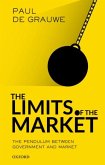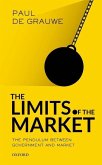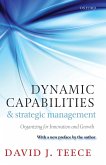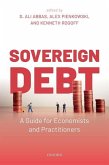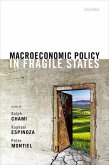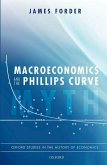Fabio-Cesare Bagliano (Professor of Economics in the Faculty of E, Giuseppe Bertola (Professor of Economic Policy in the Faculty of
Models for Dynamic Macroeconomics
Fabio-Cesare Bagliano (Professor of Economics in the Faculty of E, Giuseppe Bertola (Professor of Economic Policy in the Faculty of
Models for Dynamic Macroeconomics
- Broschiertes Buch
- Merkliste
- Auf die Merkliste
- Bewerten Bewerten
- Teilen
- Produkt teilen
- Produkterinnerung
- Produkterinnerung
Provides introduction to modern dynamic macroeconomics including consumption and investment choices, employment and unemployment outcomes, and economic growth. This work includes exercises and solutions, and suggested further reading.
Now available in paperback, this excellent book, written by two leaders in the field, provides a rigorous introduction to modern dynamic macroeconomics. The text layout has been updated to make the book more user-friendly and each chapter benefits from the inclusion of a number of exercises and solutions, as well as suggested further reading.
Andere Kunden interessierten sich auch für
![The Limits of the Market The Limits of the Market]() Paul De Grauwe (London School of Economics Professor)The Limits of the Market37,99 €
Paul De Grauwe (London School of Economics Professor)The Limits of the Market37,99 €![The Limits of the Market The Limits of the Market]() Paul De Grauwe (London School of Economics Professor)The Limits of the Market58,99 €
Paul De Grauwe (London School of Economics Professor)The Limits of the Market58,99 €![Dynamic Capabilities and Strategic Management Dynamic Capabilities and Strategic Management]() David J. Teece (, Chaired Professor, University of California, BerkDynamic Capabilities and Strategic Management35,99 €
David J. Teece (, Chaired Professor, University of California, BerkDynamic Capabilities and Strategic Management35,99 €![Sovereign Debt Sovereign Debt]() Sovereign Debt136,99 €
Sovereign Debt136,99 €![Macroecon Policy in Fragile States C Macroecon Policy in Fragile States C]() Chami Et AlMacroecon Policy in Fragile States C207,99 €
Chami Et AlMacroecon Policy in Fragile States C207,99 €![Macroeconomics and the Phillips Curve Myth Macroeconomics and the Phillips Curve Myth]() James Forder (Andrew Graham Fellow and Tutor in Political EconomyMacroeconomics and the Phillips Curve Myth151,99 €
James Forder (Andrew Graham Fellow and Tutor in Political EconomyMacroeconomics and the Phillips Curve Myth151,99 €![Introduction to Modern Economic Growth Introduction to Modern Economic Growth]() Daron AcemogluIntroduction to Modern Economic Growth68,99 €
Daron AcemogluIntroduction to Modern Economic Growth68,99 €-
-
-
Provides introduction to modern dynamic macroeconomics including consumption and investment choices, employment and unemployment outcomes, and economic growth. This work includes exercises and solutions, and suggested further reading.
Now available in paperback, this excellent book, written by two leaders in the field, provides a rigorous introduction to modern dynamic macroeconomics. The text layout has been updated to make the book more user-friendly and each chapter benefits from the inclusion of a number of exercises and solutions, as well as suggested further reading.
Now available in paperback, this excellent book, written by two leaders in the field, provides a rigorous introduction to modern dynamic macroeconomics. The text layout has been updated to make the book more user-friendly and each chapter benefits from the inclusion of a number of exercises and solutions, as well as suggested further reading.
Produktdetails
- Produktdetails
- Verlag: Oxford University Press
- Seitenzahl: 290
- Erscheinungstermin: 29. November 2007
- Englisch
- Abmessung: 234mm x 156mm x 16mm
- Gewicht: 432g
- ISBN-13: 9780199228324
- ISBN-10: 0199228329
- Artikelnr.: 22990350
- Herstellerkennzeichnung
- Libri GmbH
- Europaallee 1
- 36244 Bad Hersfeld
- gpsr@libri.de
- Verlag: Oxford University Press
- Seitenzahl: 290
- Erscheinungstermin: 29. November 2007
- Englisch
- Abmessung: 234mm x 156mm x 16mm
- Gewicht: 432g
- ISBN-13: 9780199228324
- ISBN-10: 0199228329
- Artikelnr.: 22990350
- Herstellerkennzeichnung
- Libri GmbH
- Europaallee 1
- 36244 Bad Hersfeld
- gpsr@libri.de
Fabio-Cesare Bagliano is currently Professor of Economics in the Faculty of Economics, University of Tunrin, having previously held other teaching positions in Turin and Teramo (Italy); in 1987-90 he held a research position at the Centre for Economic Performance (London School of Economics and Political Science). He is Associate Editor of Giornale degli Economisti e Annali di Economia and has published in the Journal of Banking and Finance, the European Economic Review, the Journal of Macroeconomics, and other academic journals and books. Giuseppe Bertola is Professor of Economics at the University of Turin. He has previously held other teaching positions in Turin and visiting positions in various places, including Assistant Professor and Assistant Director of the International Finance Section, Princeton University. He is a Managing Editor of Economic Policy and Condirettore of Giornale degli Economisti e Annali di Economia. His work is published in the Review of Economic Studies, American Economic Review, the European Economic Review, and other academic journals and books.
Preface
1: Dynamic Consumption Theory
1.1 Permanent Income and Optimal Consumption
1.2 Empirical Issues
1.3 The Role of Precautionary Saving
1.4 Consumption and Financial Returns
Appendix A1: Dynamic Programming
Review Exercises
Further Reading
References
2: Dynamic Models of Investment
2.1 Convex Adjustment Costs
2.2 Continuous-Time Optimization
2.3 Steady-State and Adjustment Paths
2.4 The Value of Capital and Future Cash Flows
2.5 Average Value Capital
2.6 A Dynamic IS-LM Model
2.7 Linear Adjustment Costs
2.8 Irreversible Investment Under Certainty
Appendix A2: Hamiltonian Optimization Methods
Review Exercises
Further Readings
References
3: Adjustment Costs in the Labor Market
3.1 Hiring and Firing Costs
3.2 The Dynamics of Employment
3.3 Average Long-Run Effects
3.4 Adjustment Costs and Labor Allocation
Appendix A3: (Two-State) Markov Processes
Review Exercises
Further Reading
References
4: Growth in Dynamic General Equilibrium
4.1 Production, Savings, and Growth
4.2 Dynamic Optimization
4.3 Decentralized Production and Investment Decisions
4.4 Measurement of "Progress": the Solow Residual
4.5 Endogenous Growth and Market Imperfections
Review Exercises
Further Exercises
References
5: Coordination and Externalities in Macroeconomics
5.1 Trading Externalities and Multiple Equilibria
5.2 A Search Model of Money
5.3 Search Externalities in the Labor Market
5.4 Dynamics
5.5 Externalities and Efficiency
Review Exercises
Further Reading
References
Answers to Exercises
1: Dynamic Consumption Theory
1.1 Permanent Income and Optimal Consumption
1.2 Empirical Issues
1.3 The Role of Precautionary Saving
1.4 Consumption and Financial Returns
Appendix A1: Dynamic Programming
Review Exercises
Further Reading
References
2: Dynamic Models of Investment
2.1 Convex Adjustment Costs
2.2 Continuous-Time Optimization
2.3 Steady-State and Adjustment Paths
2.4 The Value of Capital and Future Cash Flows
2.5 Average Value Capital
2.6 A Dynamic IS-LM Model
2.7 Linear Adjustment Costs
2.8 Irreversible Investment Under Certainty
Appendix A2: Hamiltonian Optimization Methods
Review Exercises
Further Readings
References
3: Adjustment Costs in the Labor Market
3.1 Hiring and Firing Costs
3.2 The Dynamics of Employment
3.3 Average Long-Run Effects
3.4 Adjustment Costs and Labor Allocation
Appendix A3: (Two-State) Markov Processes
Review Exercises
Further Reading
References
4: Growth in Dynamic General Equilibrium
4.1 Production, Savings, and Growth
4.2 Dynamic Optimization
4.3 Decentralized Production and Investment Decisions
4.4 Measurement of "Progress": the Solow Residual
4.5 Endogenous Growth and Market Imperfections
Review Exercises
Further Exercises
References
5: Coordination and Externalities in Macroeconomics
5.1 Trading Externalities and Multiple Equilibria
5.2 A Search Model of Money
5.3 Search Externalities in the Labor Market
5.4 Dynamics
5.5 Externalities and Efficiency
Review Exercises
Further Reading
References
Answers to Exercises
Preface
1: Dynamic Consumption Theory
1.1 Permanent Income and Optimal Consumption
1.2 Empirical Issues
1.3 The Role of Precautionary Saving
1.4 Consumption and Financial Returns
Appendix A1: Dynamic Programming
Review Exercises
Further Reading
References
2: Dynamic Models of Investment
2.1 Convex Adjustment Costs
2.2 Continuous-Time Optimization
2.3 Steady-State and Adjustment Paths
2.4 The Value of Capital and Future Cash Flows
2.5 Average Value Capital
2.6 A Dynamic IS-LM Model
2.7 Linear Adjustment Costs
2.8 Irreversible Investment Under Certainty
Appendix A2: Hamiltonian Optimization Methods
Review Exercises
Further Readings
References
3: Adjustment Costs in the Labor Market
3.1 Hiring and Firing Costs
3.2 The Dynamics of Employment
3.3 Average Long-Run Effects
3.4 Adjustment Costs and Labor Allocation
Appendix A3: (Two-State) Markov Processes
Review Exercises
Further Reading
References
4: Growth in Dynamic General Equilibrium
4.1 Production, Savings, and Growth
4.2 Dynamic Optimization
4.3 Decentralized Production and Investment Decisions
4.4 Measurement of "Progress": the Solow Residual
4.5 Endogenous Growth and Market Imperfections
Review Exercises
Further Exercises
References
5: Coordination and Externalities in Macroeconomics
5.1 Trading Externalities and Multiple Equilibria
5.2 A Search Model of Money
5.3 Search Externalities in the Labor Market
5.4 Dynamics
5.5 Externalities and Efficiency
Review Exercises
Further Reading
References
Answers to Exercises
1: Dynamic Consumption Theory
1.1 Permanent Income and Optimal Consumption
1.2 Empirical Issues
1.3 The Role of Precautionary Saving
1.4 Consumption and Financial Returns
Appendix A1: Dynamic Programming
Review Exercises
Further Reading
References
2: Dynamic Models of Investment
2.1 Convex Adjustment Costs
2.2 Continuous-Time Optimization
2.3 Steady-State and Adjustment Paths
2.4 The Value of Capital and Future Cash Flows
2.5 Average Value Capital
2.6 A Dynamic IS-LM Model
2.7 Linear Adjustment Costs
2.8 Irreversible Investment Under Certainty
Appendix A2: Hamiltonian Optimization Methods
Review Exercises
Further Readings
References
3: Adjustment Costs in the Labor Market
3.1 Hiring and Firing Costs
3.2 The Dynamics of Employment
3.3 Average Long-Run Effects
3.4 Adjustment Costs and Labor Allocation
Appendix A3: (Two-State) Markov Processes
Review Exercises
Further Reading
References
4: Growth in Dynamic General Equilibrium
4.1 Production, Savings, and Growth
4.2 Dynamic Optimization
4.3 Decentralized Production and Investment Decisions
4.4 Measurement of "Progress": the Solow Residual
4.5 Endogenous Growth and Market Imperfections
Review Exercises
Further Exercises
References
5: Coordination and Externalities in Macroeconomics
5.1 Trading Externalities and Multiple Equilibria
5.2 A Search Model of Money
5.3 Search Externalities in the Labor Market
5.4 Dynamics
5.5 Externalities and Efficiency
Review Exercises
Further Reading
References
Answers to Exercises


